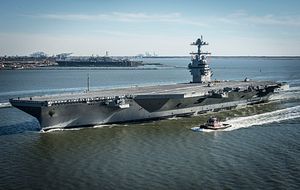The U.S. Navy is weighing whether it can reduce costs and expedite its goals of a 355-ship fleet in the 2030s by procuring two rather than one nuclear-powered Gerald R. Ford-class aircraft carrier in a single buy, the service announced on March 20.
The U.S. Navy has released a Request for Proposal to U.S. ship maker Huntington Ingalls Industries – Newport News Shipbuilding (HII-NNS), the Ford-class’ builder, on March 19 to “further define the cost savings achievable with a two-ship buy,” according to the service’s statement.
“With lethality and affordability a top priority, the Navy has been working with HII-NNS over the last several months to estimate the total savings associated with procuring CVN 80 and CVN 81 as a two-ship buy.”
The U.S. Navy intends to operate a fleet of 12 Ford-class carriers, up from the 11 Nimitz-class currently in service, by the end of the 2030s. Should all criteria be met, a two-ship buy contract is expected to be awarded in early 2019, pending congressional approval. Yet the dual-buy procurement will only occur if HII-NNS demonstrates a significant reduction in labor and material costs.
“In keeping with the National Defense Strategy, the Navy developed an acquisition strategy to combine the CVN 80 and CVN 81 procurements to better achieve the Department’s objectives of building a more lethal force with greater performance and affordability,” James F. Geurts, assistant secretary of the Navy for research development and acquisition said this week. “This opportunity for a two-ship contract is dependent on significant savings that the shipbuilding industry and government must demonstrate. The Navy is requesting a proposal from HII-NNS in order to evaluate whether we can achieve significant savings.”
A HII-NNS representative told Bloomberg News in an email that “we believe the most effective way to reduce cost of aircraft carriers is to take a multi-ship purchase approach and build them every three to four years. Buying two ships at once stabilizes the Newport News Shipbuilding workforce and their national supplier base, allows us to buy materials in quantity, and phase work more efficiently.”
Controlling the cost of the Ford-class program has been a big challenge for the U.S. Navy, with cost overruns around $2.3. billions so far. The first-of-class USS Gerald R. Ford (CVN-78), commissioned in July 2017, is already the U.S. Navy’s most expensive warship in its history, with total cost amounting to almost $13 billion. The per-unit cost of the remaining ships of the class is estimated at around $10 billion. The Ford’s follow-on, the future USS John F. Kennedy CVN-79), will likely be commissioned in 2020.
The third ship of the class, USS Enterprise (CVN-80), could join the fleet in 2027. The fourth Ford-class carrier (CVN-81) has not been named yet but could enter service by 2029 or 2030. The USS Gerald R. Ford is scheduled for its first operational deployment in 2022, although that date could be moved up to 2019 or 2020 as U.S. Congress is considering striking the requirement for the ship to undergo shock trials.
































